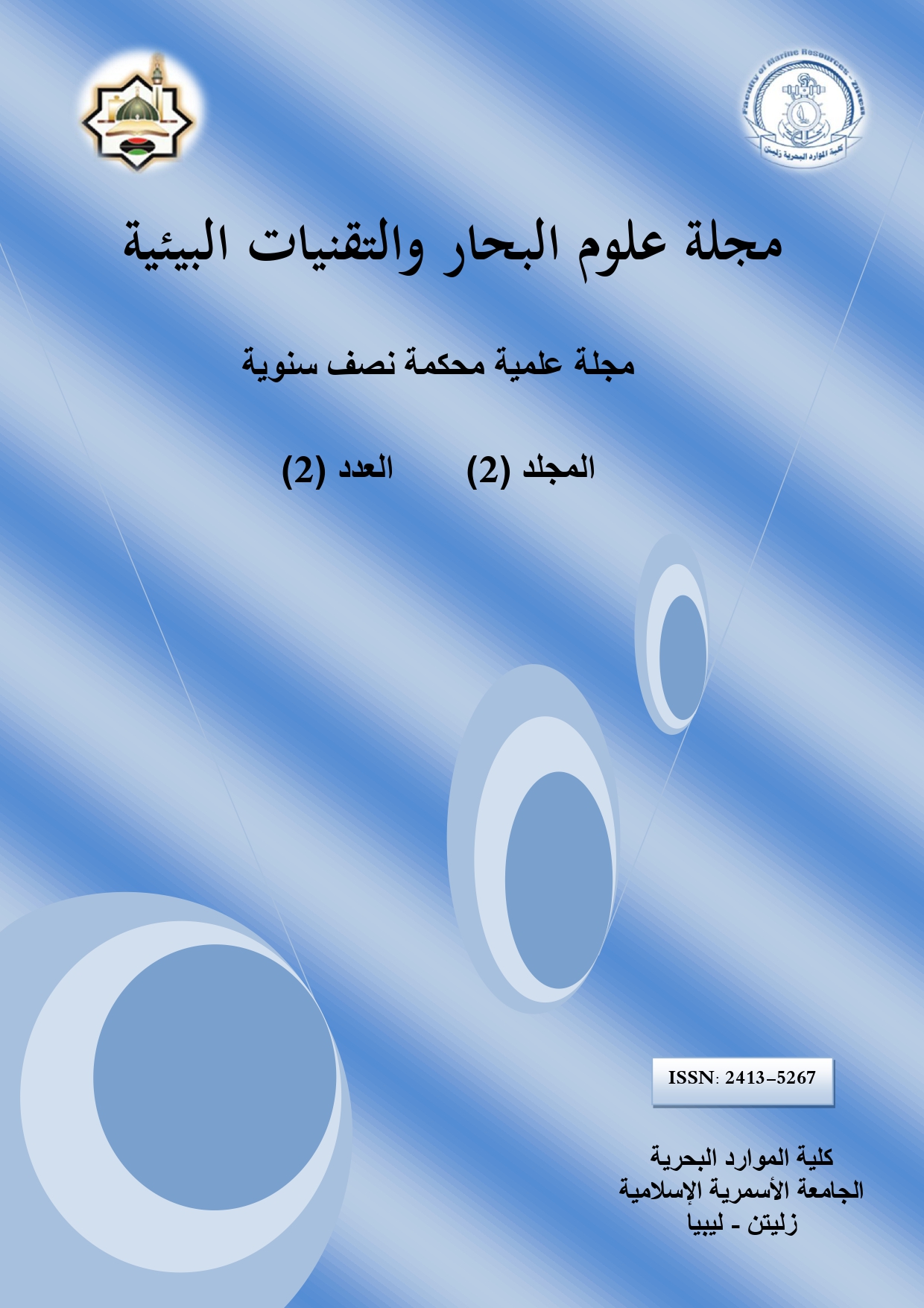تقييم المياه الجوفية الضحلة (طبقة حاوية غير محصورة) لبعض آبار مياه منطقة مصراتة ومدى ملائمتها للشرب والري
DOI:
https://doi.org/10.59743/jmset.v2i2.104الكلمات المفتاحية:
نوعية المياه، تداخل مياه البحر، الاملاح الذائبة الكلية، المياه الجوفية لمدينة مصراتة، خزان الأيوسين الجوفيالملخص
منطقة مصراتة هي أحد أكبر المدن الليبية من حيث كثافة السكان تقع في منتصف الجزء الشمالي للساحل الليبي شرق مدينة طرابلس بحوالي (200 كم). تعتبر المياه الجوفية هي المصدر الرئيسي للمياه في هذه المنطقة والتي يُعتمد عليها في تلبية جميع احتياجات السكان من شرب، زراعة، صناعة بالإضافة إلى الاستخدامات الأخرى. حيث يوجد بها العديد من الآبار الضحلة والتي يتراوح عمقها من 30 إلى 150م. كما يوجد بها عددا محدودا من الآبار الارتوازية (العميقة). في هذه الدراسة تم اختيار عدد 31 بئراً ضحلة (طبقة حاوية غير محصورة) منتشرة بالمنطقة لغرض تصنيف نوعية المياه وتقييم استخدامها للأغراض المختلفة وأيضا تحديد مصدر الملوحة لهذه المياه. تم قياس درجة الحموضة، الموصلية الكهربائية لعينات المياه في الحقل، بالإضافة إلى تحليل العناصر الرئيسية في المختبر كما تم تقدير العسرة الكلية للمياه والأملاح الذائبة الكلية. إضافة إلى ذلك تم استخدام المعادلات القياسية لتقدير نسبة الصوديوم المدمص، نسبة الصوديوم الذائب، العسرة الكلية، نسبة الماغنيسيوم ومؤشر النفاذية. بناءً على نتائج التحليل تم تقسيم المياه حسب الأيونات السائدة إلى نوعين مجموعة أيونات الكالسيوم والماغنسيوم مع الكلوريدات ومجموعة أيونات الصوديوم و الكالسيوم مع الكلوريدات (Cl-Na.Ca و Ca.Mg-Cl) أيضاً تم تصنف المياه الجوفية الضحلة لهذه المنطقة إلى مياه عسرة و متوسطة إلى شديدة الملوحة. بينت نتائج الاختبارات المعملية للمياه الجوفية الضحلة للمنطقة بأن مياهها تعتبر متدنية النوعية وغير صالحة للشرب ولا للزراعة وذلك استناداً على مواصفات المركز الوطني الليبي لمياه الشرب (1992)، معايير الصحة العالمية (2011)، منظمة الزراعة والأغذية (1989)، وكالة حماية البيئة الأمريكية مع ملاحظة أنها قد تكون ملائمة لري بعض المحاصيل الزراعية تحت ظروف معينة. كما أوضحت نتائج الدراسة أيضًا أن مصدر الأملاح يعود الى تداخل مياه البحر مع مياه خزان الأيوسين الجوفي لهذه المنطقة.
المراجع
قائمة المراجع باللغة العربية
أحمد، ج.ط. (2000). الموارد المائية في الجماهيرية الليبية حجم العجز المائي وحصة الأجيال المستقبلية. بحث غير منشور.
الحياني, ع. (2009). تقييم المياه الجوفية لبعض آبار قرية الخفاجية في محافظة الأنبار. مجلة جامعة الأنبار للعلوم والمعرفة, 3(2).
العرابي، ع. (2008). المصادر المائية في المغرب العربي وامكانية تطوير استغلالها بما يخدم التنمية المستدامة. دليل استعمال المكتبة المغاربية المصغرة, اليونسكو, الرباط.
اللجنة الفنية لدراسة الوضع المائي في ليبيا (1999). دراسة الوضع المائي للجماهيرية والاستراتيجية الوطنية لإدارة الموارد المائية للفترة من 2000 إلى 2025. اللجنة الشعبية العامة , تقرير غير منشور.
الهيئة العامة للمياه (1974). تقرير عن مصادر المياه الجوفية بمناطق زليطن- مصراتة - تاورغاء، على ضوء دراسة جيفلي.
الهيئة العامة للمياه (2000). تقرير عن مياه الشرب بمنطقة مصراتة والوضع المائي للخزانات الجوفية بالمنطقة، فرع المنطقة الوسطى.
بخيت, ن. (2008). المياه العربية :الواقع والتحديات. مجلة الغرى للعلوم االإقتصادية والإدارية، 10(2): 91-108.
جناد، أ. (2005). أنشطة المركز العربي لدراسة المناطق الجافة والأراضي القاحلة في حصاد المياه. حلقة عمل حول حصاد مياه الأمطار والتغذية الاصطناعية، طرابلس، ليبيا (10-13 أكتوبر).
خدام، م. (2004). المياه العربية الازمة والمشكلات والحلول. مجلة الحوار المتمدن، العدد 939.
صقر, إ و معروف، إ. (2006). مصادر تلوث المياه الجوفية في الساحل السوري نتيجة الأنشطة البشرية وانعكاساته. المؤتمر الدولي الثاني للموارد المائية والبيئة الجافة.
غازي, ع. (2010) . البيئة الصناعية تحسينها وطرق حمايتها. دار دجلة، جمهورية العراق.
محمد، أ. م. (2004). التقييم الهيدروجيوكيميائي للمياه الجوفية المتوضعة في الصخور الكربوناتية. مجلة بحوث جامعة تشرين, سوريا، 26(1).
مخيمر، س. و حجازي ، خ. (1996). أزمة المياه في المنطقة العربية: الحقائق والبدائل الممكنة. سلسلة كتب عالم المعرفة، المجلس الوطني للثقافة والفنون والآداب ، الكويت.
مركز البحوث الصناعية (1975). لوحة مصراتة, رقم (ش.ذ. 33-15)، الكتيب التفسيري، خريطة ليبيا الجيولوجية بمقياس رسم: 250,000:1.
مصلحة الأرصاد الجوية مصراتة (2014)، بيانات غير منشورة.
مصلحة المساحة الجيولوجية (1964). خرائط المياه الجوفية للمملكة الليبية. وضع جميس جونز، تقرير مفتوح.
قائمة المراجع باللغة الإنجليزية
APHA (1975). Standard methods for the examination of water and waste water. American Health Association, 14th. Ed. Washington DC.
Doneen L.D. (1964). Notes on Water Quality in Agriculture. Water Science and Engineering Paper 4001. Department of Water Sciences and Engineering, Univ. of California.
Gefli (1973). Groupement D’Etude Francais En libye Siege Social. Survey for the development of the central wadi zone and Gulf of Sirt. 8 rue Jean Goujon 75008 Paris.
Hagen (1987). Irrigation of agricultural land. Agronomy series, 11: 10-14.
Kovda V.A. (1973). Irrigation , Drainage and salinity, Hutchinson Co., London , England.
LNCSDWS (Libyan National Center for Specifications and Drinking Water Standards). No. 82, (1992).
Paliwal K.V. (1972). Irrigation with Saline Water. ICARI Monograph No. 2 (New Series). New Delhi., India.
Ragunath H.M. (1987). Groundwater. Wiley Eastern Ltd., New Delhi, India.
Schoeller H. (1962). Lex eaux souterraines, hydrologic dynamique et Evaluation Des Resources, Masson and C, Paris.
Sullin V.A. (1946). Oil water in the system of natural groundwater. Gostopichezdat, Moscow USSR, 215, 30(1): 37-45.
USSL (United States Salinity Laboratory), (1954). Diagnosis and Improvement of Saline and Alkali Soils. Agricultural Handbook, vol. 60. USA.
WHO (2006). Guidelines for Drinking-water Quality. Incorporating First Addendum to Third Edition. Recommendations, Geneva, Switzerland.
Wilcox L.V. (1955). Classification and use of irrigation water. USDA, Circular, Washington, DC, USA.
التنزيلات
منشور
إصدار
القسم
الرخصة
الحقوق الفكرية (c) 2016 مجلة علوم البحار والتقنيات البيئية

هذا العمل مرخص بموجب Creative Commons Attribution 4.0 International License.









